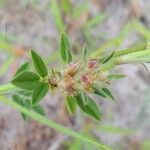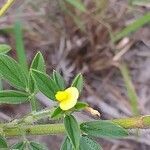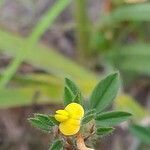Woody herb or subshrub, sometimes only a short-lived perennial, mostly erect but sometimes prostrate, 0.1-1 m long or tall; rootstock mostly thick and woody. Stems pubescent to densely spreading-hairy and often with sparse to dense bristles as well, frequently glandular. Leaflets 5-33 x 1-9 mm, elliptic or lanceolate, rounded to acute at both ends, usually pubescent and sparsely to rather densely bristly as well, rarely glabrescent; lateral nerves often conspicuously thickened towards the margins; free part of petiole and rhachis together 4-15 mm long; petiolules 0.5 mm long; stipules 8-16 mm long. Inflorescences dense; peduncle 0-5.5 cm long; rhachis 1-1.5(4) cm long; primary bracts 1.2- long, sparsely to densely pubescent and bristly; secondary bracts 4-6 x 1.5 mm; bracteoles 2, 3.5-5 mm long; plumose axis usually present, 3-10 mm long. Receptacle 5-7 mm long; calyx lobes 2.5-3 x 0.7-1 mm, oblong. Standard creamy-white to orange-coloured, with red veins and a red mark near the base inside, 5-7 x 4-5 mm; wings and keel yellow or orange-yellow. Fruit 4-9 mm long, 1-2-jointed, the articles 3.5-4 x2-2.5 mm, usually densely pubescent; beaks 1.5-2.5 mm long. Seeds chestnut-brown, shiny, 2.5-3 x 2-2.5 x 1-1.2 mm, compressed-ellipsoid, beaked or pointed near the hilum.
A woody herb or small shrub. It grows up to 1 m tall. It can be erect or lie along the ground. It has a thick woody rootstock. The leaflets are 1-3.3 cm long by 1-9 mm wide. They can be hairy. The flowers are in a dense group. They are white to orange and with red veins. The pods are 4-9 mm long and have 1 or 2 joints. The seeds are chestnut brown and 3 mm long.
Leaflets 5–33 × 1–9 mm, elliptic or lanceolate, rounded to acute at both ends, usually pubescent and sparsely to rather densely bristly as well, rarely glabrescent; lateral nerves often conspicuously thickened towards the margins; free part of petiole and rhachis together 4–15 mm long; petiolules 0.5 mm long; stipules 8–16 mm long.
Inflorescences dense; peduncle 0–5.5 cm long; rhachis 1–1.5(4) cm long; primary bracts 1.2–2 cm long, sparsely to densely pubescent and bristly; secondary bracts 4–6 × 1.5 mm; bracteoles 2, 3.5–5 mm long; plumose axis usually present, 3–10 mm long.
Woody herb or subshrub, sometimes only a short-lived perennial, mostly erect but sometimes prostrate, 0.1–1 m long or tall; rootstock mostly thick and woody.
Standard creamy-white to orange-coloured, with red veins and a red mark near the base inside, 5–7 × 4–5 mm; wings and keel yellow or orange-yellow.
Stems pubescent to densely spreading-hairy and often with sparse to dense bristles as well, frequently glandular.
Fruit 4–9 mm long, 1–2-jointed, the articles 3.5–4 × 2–2.5 mm, usually densely pubescent; beaks 1.5–2.5 mm long.
Seeds chestnut-brown, shiny, 2.5–3 × 2–2.5 × 1–1.2 mm, compressed-ellipsoid, beaked or pointed near the hilum.
Receptacle 5–7 mm long; calyx lobes 2.5–3 × 0.7–1 mm, oblong.



